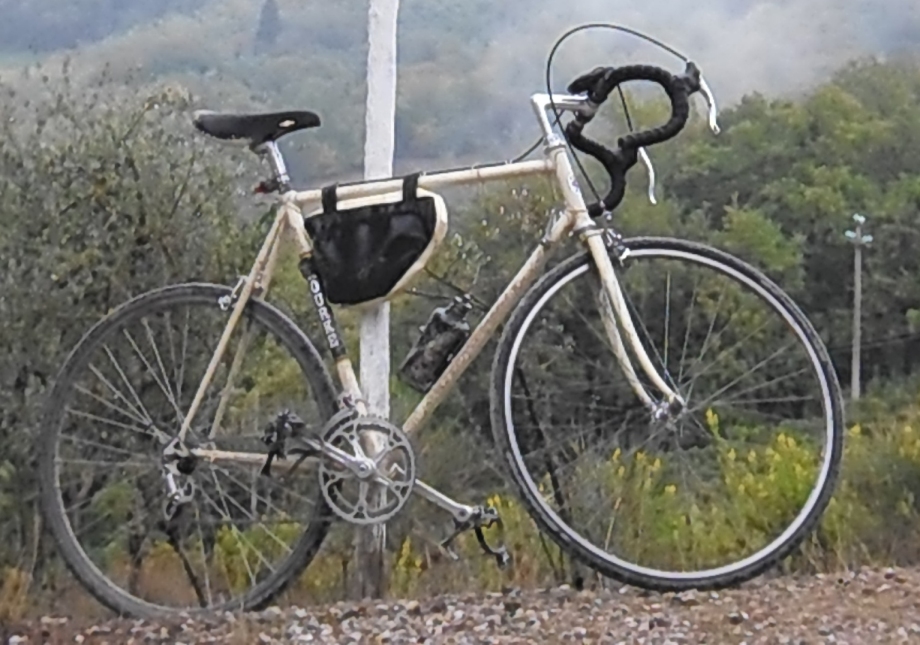Cycling heroes
Largely because of Kyla’s attention to sportives, I’ve been able to ride with some of the people in Britain who have made modern cycling and whom I admire immensely. I didn’t start cycling because of them, and I don’t cycle now for them, but they’re my cycling heroes, people who make every day of cycling a better day.
My first ride of this sort was on a sportive sponsored by Bradley Wiggens, later in the summer of 2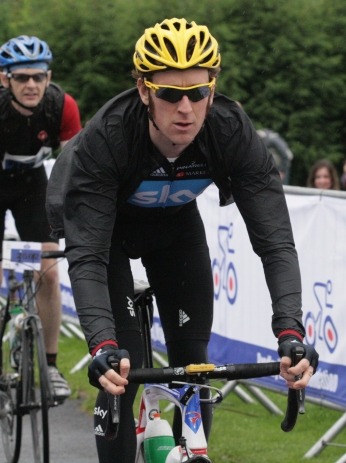 012 after he’d won the Tour de France and gold at the London Olympics. The sportive itself was a mixed bag, blessed by a peloton of sheep crossing our route, but otherwise toward the disorganised end of the spectrum of sportives. Wiggins, though, is a wonderful figure for cycling: thoughtful, generous, complicated and conflicted, even angst-ridden (listen to his Desert Island Disks interview on BBC Radio 4). In the Tour, he’d disciplined the peloton to hold in place after a vandal threw tacks on the road. Compared with Tommy Simpson who died on the Tour in 1967, it was a small moment, but it highlighted Wiggens’ fundamental decency: a drive to win, but to win fairly.
012 after he’d won the Tour de France and gold at the London Olympics. The sportive itself was a mixed bag, blessed by a peloton of sheep crossing our route, but otherwise toward the disorganised end of the spectrum of sportives. Wiggins, though, is a wonderful figure for cycling: thoughtful, generous, complicated and conflicted, even angst-ridden (listen to his Desert Island Disks interview on BBC Radio 4). In the Tour, he’d disciplined the peloton to hold in place after a vandal threw tacks on the road. Compared with Tommy Simpson who died on the Tour in 1967, it was a small moment, but it highlighted Wiggens’ fundamental decency: a drive to win, but to win fairly.
I don’t think I actually saw him—he started after I started, rode a longer route, and, naturally, finished before me—but Kyla got this lovely photo.
Last year, I rode two sportives sponsored by cyclists I admire. I should say that all these rides are charity events, with part of the entry fee going to a charity. Like many poorer sports, and in contrast with wealthy sports like football, cyclists seem remarkably generous. Sportive riders seem as much motivated by making a charitable contribution as by the desire to lose weight, get fit, or “win.”
At Mark Cavendish’s Rise Above sportive out of Chester, Cavendish cam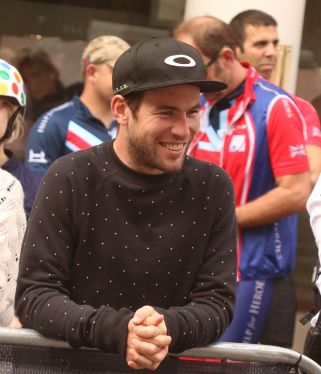 e out and talked with the starters, including the teams riding for Help for Heroes, the charity that supports injured veterans and one of the sponsors of the sportive. Cavendish seemed remarkably comfortable in his skin—I saw him, but didn’t get a chance to talk with him—chatting with the starters, having his picture taken with the Help for Heroes team. Again, I chose a shorter route and missed Cav overtaking me. Good ride, though.
e out and talked with the starters, including the teams riding for Help for Heroes, the charity that supports injured veterans and one of the sponsors of the sportive. Cavendish seemed remarkably comfortable in his skin—I saw him, but didn’t get a chance to talk with him—chatting with the starters, having his picture taken with the Help for Heroes team. Again, I chose a shorter route and missed Cav overtaking me. Good ride, though.
At the end of the summer, I rode the Hoy 100, an event sponsored by Chris Hoy. I did the whole “Hoy experience,” listening to a brief talk and a Q&A with Hoy, followed by budget lasagne and garlic bread, dressed up as “carbo loading” for the ride the next day. It was a great experience; Hoy answered honestly and thoughtfully the questions from the audience, like the girl who asked something like, “How do I prepare, how do I become competitive?” His answer was something like, “Don’t worry about the bike, work on your experience and opportunities. Ride hard.” I met Graeme Obree, who was there to support his fellow Scot. In competition with Chris Boardman in the early 1990s, Obree traded the world hour record, each of them improving bikes along the way. He’s another good, sharp cyclist, who generously gave his time to support Hoy and was willing to accommodate fans. Again, a wonderful ride.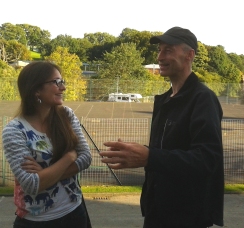
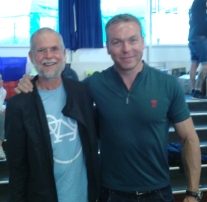
The other cyclist I met I’ve never been able to ride with. About 2010, the BBC ran a television programme about Robert Penn’s effort to create the “Ride of My Life.” He wanted a bicycle that would do him for the rest of his life, and he started with a Brian Rourke frame. I should include Penn as a cycling—and writing—hero. His programme and his book moved me, and probably many others, into cycling or up to a new level.
But the person I’m focusing on here is Brian Rourke. When the programme ran, I had built my fixie, starting with a Raleigh frame Kyla bought on eBay. A custom Rourke frame, kitted out, was beyond my means, but we bought someone else’s Rourke on eBay. Re-doing the Rourke is a story for another day, but after I stripped it, we took it to Brian Rourke Cycles in Stoke-on-Trent to have it repainted. When we came to pick up the finished bike, I met Brian Rourke, who’s simply a wonderful person. He assured us the bike was a Rourke, though he couldn’t match the frame number to his records. It was built about 1980 and their record keeping thirty years ago wasn’t what it is now.
Brian Rourke is a living recommendation for cycling as a way to keep healthy. When we picked up the bike, we estimated he was about 75. Sharp, spry and generous, the frame was on a rack over the counter in the main room of the store. He leapt onto the counter, about four feet up, and brought it down. Penn says that Rourke was a top racer in his day, Britain’s National Champion, but couldn’t make a living in competitive cycling, so he packed in his racing career in 1967. “Racing’s loss was the frame-building industry’s gain.” Rourke Cycles have built beautiful frames for riders, including Nicole Cooke, and, through the Cat and Fiddle sportive, they make a major contribution to the Cystic Fibrosis Trust. Brian Rourke is one of my cycling heroes. I don’t have a picture of him, and for that I’m very sorry, but here’s my Rourke covered with the wet dust of the strade bianche of the Eroica in Gaiole.